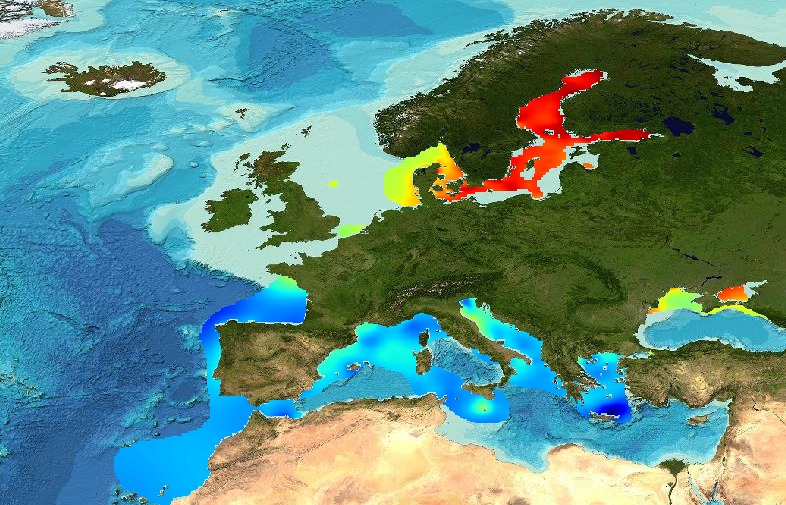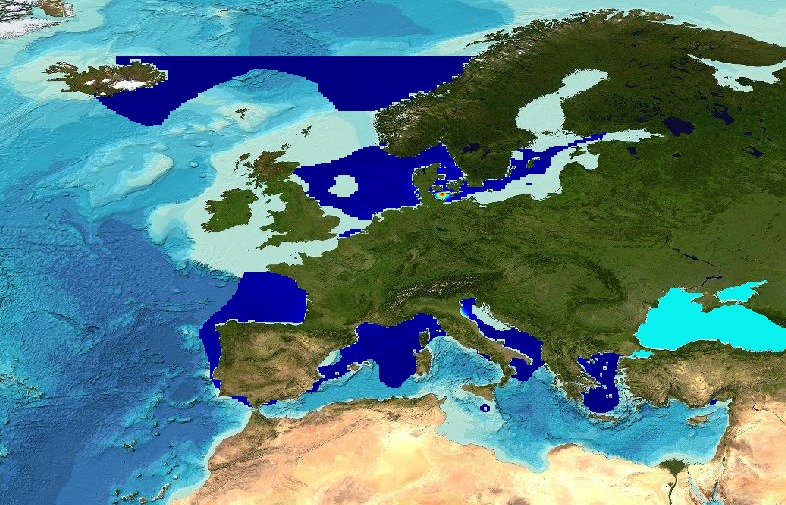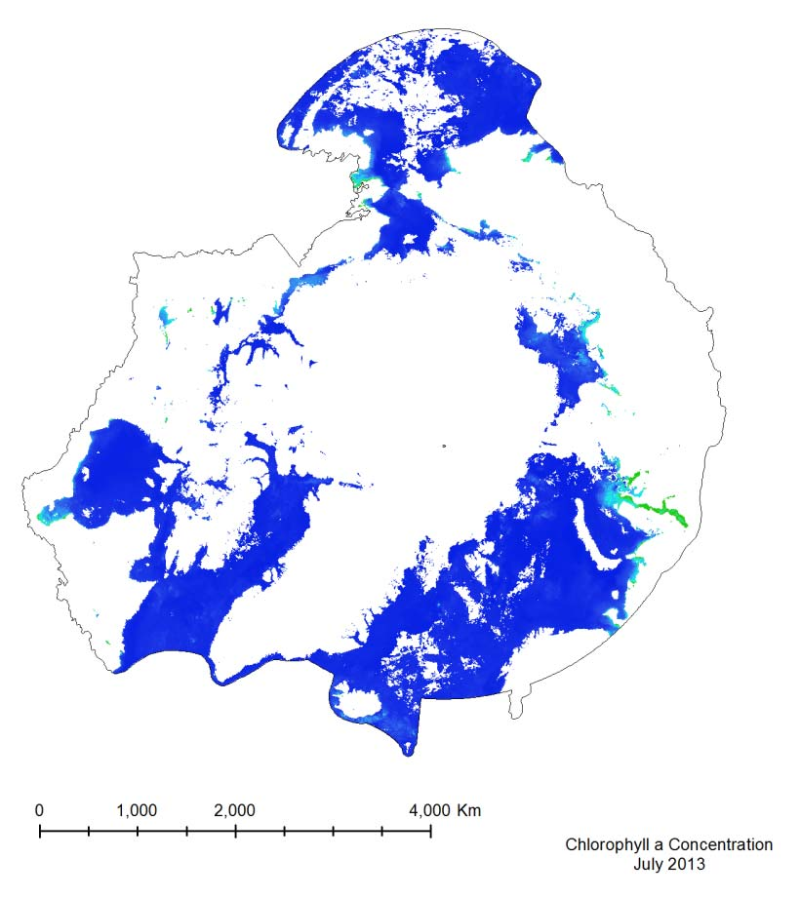Oceanographic geographical features
Type of resources
Available actions
Topics
Keywords
Contact for the resource
Provided by
Years
Formats
Representation types
Update frequencies
status
Service types
Scale
Resolution
-
EMODnet Physics - TEMP_004 - Temperature monthly climatology for North Atlantic Ocean, Baltic Sea, Arctic Sea, Mediterranean Sea and Black Sea, covering the period from 1900 to 2014. This product is based on the SeaDataNet aggregated dataset v1.1.
-
Shapefile showing areas where ice concentration in the Barents Sea in 2018 was on average more than 20%. The 20% threshold was derived from WMO ice classification and corresponds to "Very open drift ice". Data averaged by Ifremer and NIVA derived from CMEMS (Copernicus) ice concentration product (resolution 1km, temporal resolution 1 year- 2018). Used in EUSeaMap 2019 as a proxy for the polar front affecting distribution of seabed habitats. Created by the EMODnet Seabed Habitats project consortium.
-
EMODnet Physics - Arctic Sea Ice Extend [2009 - ongoing] - Annual Max and Min contours. This product uses the Copernicus Marine Service product id. SEAICE_GLO_SEAICE_L4_NRT_OBSERVATIONS_011_001
-
This layer was created for the EUSeaMap 2019. It was computed from the CMEMS product "ARCTIC OCEAN - SEA ICE CONCENTRATION CHARTS - SVALBARD" (product identifier: SEAICE_ARC_SEAICE_L4_NRT_OBSERVATIONS_011_002). Daily values were averaged over the year 2018
-

The analysis was performed per season using DIVA software tool (Data-Interpolating Variational Analysis). The analyses products are stored as NetCDF CF files and made available as WMS layers for easy browsing and adding. Every step of the time dimension corresponds to a 6-year moving average from 1983 to 2016. The depth dimension spans from surface to 1000 m, with 21 vertical levels. The boundaries and overlapping zones between these regions were filtered to avoid any unrealistic spatial discontinuities. This combined water body dissolved oxygen concentration product is masked using the relative error threshold 0.5. Units: µmol/l Created by 'University of Liège, GeoHydrodynamics and Environment Research (ULiège-GHER)'. The data used as input for DIVA have been extracted from the EMODnet Chemistry Download Service: https://emodnet-chemistry.maris.nl/search Intermediate regional data products: Mediterranean Sea - DIVA 4D 6-year analysis of Water body dissolved oxygen concentration 1971/2017 v2018, Arctic Ocean - DIVA 4D 6-year analysis of Water body dissolved oxygen concentration 1980/2017 v2018, North Sea - DIVA 4D 6-year analysis of Water body dissolved oxygen concentration 1980/2017 v2018, Black Sea - DIVA 4D 6-year analysis of Water body dissolved oxygen concentration 1990/2016 v2018, North East Atlantic Ocean - DIVA 4D 6-year analysis of Water body dissolved oxygen concentration 1960/2017 v2018, Baltic Sea - DIVA 4D 6-year analysis of Water body dissolved_oxygen_concentration 1980/2016 v2018
-
Arctic mask shapefile produced by EMODnet Seabed Habitats as an input layer for the 2021 EUSeaMap broad-scale habitat model. Used in as a proxy to delimit the Arctic zone and it is used to classify shallow habitats into Arctic habitat classes as required by the EUNIS (V. 2019) habitat classification. The masks covers areas in the Barents Sea which are North of the polar front or where ice concentration exceeded 20% on average in 2018. The 20% threshold was derived from WMO ice classification and corresponds to "Very open drift ice". Created by the EMODnet Seabed Habitats project consortium. A report on the methods used in the 2021 version of EUSeaMap (Vasquez et al., 2021) and reports on previous versions (v2016 and V2019) are linked in Online Resources. Credit: Licensed under CC-BY 4.0 from the European Marine Observation and Data Network (EMODnet) Seabed Habitats initiative (www.emodnet-seabedhabitats.eu), funded by the European Commission.
-

The analysis was performed per season using DIVA software tool (Data-Interpolating Variational Analysis). The analyses products are stored as NetCDF CF files and made available as WMS layers for easy browsing and adding. Every step of the time dimension corresponds to a 6-year moving average from 1983 to 2016. The depth dimension spans from surface to 1000 m, with 21 vertical levels. The boundaries and overlapping zones between these regions were filtered to avoid any unrealistic spatial discontinuities. This combined water body dissolved oxygen concentration product is masked using the relative error threshold 0.5. Units: µmol/l Created by 'University of Liège, GeoHydrodynamics and Environment Research (ULiège-GHER)'. The data used as input for DIVA have been extracted from the EMODnet Chemistry Download Service: https://emodnet-chemistry.maris.nl/search Intermediate regional data products: Mediterranean Sea - DIVA 4D 6-year analysis of Water body chlorophyll-a 1990/2017 v2018, Arctic Ocean - DIVA 4D 6-year analysis of Water body chlorophyll-a 1980/2017 v2018, Black Sea - DIVA 4D 6-year analysis of Water body chlorophyll-a 1990/2016 v2018, North East Atlantic Ocean - DIVA 4D 6-year analysis of Water body chlorophyll-a 1960/2017 v2018, North Sea - DIVA 4D 6-year analysis of Water body chlorophyll-a 1980/2017 v2018, Baltic Sea - DIVA 4D 6-year analysis of Water body chlorophyll-a 1980/2016 v2018
-
In the Northwest Atlantic, Pandalus borealis (northern shrimp) serve as key mid-trophic consumers and prey for higher-trophic predators, including commercially important fish species. However, the impact of changing environmental conditions on trophic interactions and lipid storage in sub-Arctic ecosystems is not well understood. We employed biochemical tracers (fatty acids and stable isotopes) to investigate the trophic ecology and stage-specific nutritional condition of P. borealis across spatial and seasonal scales. A total of 68 different fatty acids (FAs) were identified in P. borealis tissues (i.e., muscle and eggs). The relative abundances of these FAs varied among sex, tissues, seasons, and fishing areas. Results revealed that P. borealis primarily fed on diatoms and zooplankton, with opportunistic feeding on sinking phytodetritus. Lipid composition showed strong seasonality, with storage triacylglycerols being the predominant lipid class. Ovigerous females exhibited the highest lipid concentrations and essential fatty acids, emphasizing the ecological importance of eggs as high-quality lipid sources. Additionally, total lipid content in eggs increased from spring to summer, highlighting vulnerability to shifts in seasonal primary production. This study underscores the significant seasonal variability in the nutritional status of P. borealis and the need to understand lipid dynamics to assess population resilience to environmental changes. Important Note: This submission has been initially submitted to SEA scieNtific Open data Edition (SEANOE) publication service and received the recorded DOI. The metadata elements have been further processed (refined) in EMODnet Ingestion Service in order to conform with the Data Submission Service specifications.
-

The MODIS marine chlorophyll a product provided, similar to SST, is a 4 km global monthly composite based on smaller resolution daily imagery compiled by NASA. The imagery is reliant on clear ocean (free of clouds and ice) so only months from March to October have been provided, as the chlorophyll levels in the Arctic diminish during the winter months, when sea ice is prevalent. The marine chlorophyll a is measured in mg/m3
-
Shapefile showing areas where ice concentration in the Barents Sea in 2018 was on average more than 20%. The 20% threshold was derived from WMO ice classification and corresponds to "Very open drift ice". Data averaged by Ifremer and NIVA derived from CMEMS (Copernicus) ice concentration product (resolution 1km, temporal resolution 1 year- 2018). Used in EUSeaMap 2021 to create the Arctic mask layer as an input layer for the 2021 EUSeaMap broad-scale habitat model Created by the EMODnet Seabed Habitats project consortium. A report on the methods used in the 2021 version of EUSeaMap (Vasquez et al., 2021) and reports on previous versions (v2016 and V2019) are linked in Online Resources. Credit: Licensed under CC-BY 4.0 from the European Marine Observation and Data Network (EMODnet) Seabed Habitats initiative (www.emodnet-seabedhabitats.eu), funded by the European Commission.
 Arctic SDI catalogue
Arctic SDI catalogue